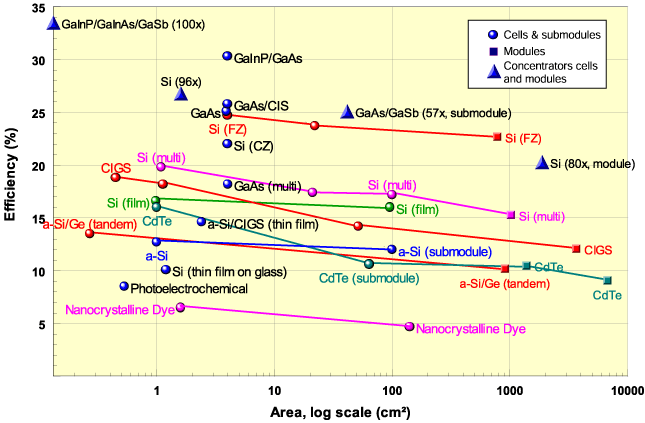| Classification | Efficiency | Device Description | Area (cm²) | Voc (V) | Jsc(mA/cm²) | FF (%) |
|---|---|---|---|---|---|---|
| Cell (concentrator) | 41.1 % | Ga0.35In0.65P/Ga0.83In0.17As/Ge triple-junction, 454x, AM1.5d. (Fraunhofer-ISE 1) | 0.0509 | 2.867 | Isc = 380.5 mA | 87.2 |
| Cell at one-sun | 35.8 % | InGaP/GaAs/InGaAs (Sharp 2) | 3.989 (t) | 2.622 | 14.37 | 85 |
| Silicon cell (one -sun) | 25 % | UNSW PERL 3 | 4.00 (da) | 0.706 | 42.7 | 82.8 |
| Module (concentrator) | 27 % | Entech 4 | 34 (ap) | |||
| Module (one-sun) | 22.7 % | UNSW PERL 5 | 778 (da) | 5.6 | 3.93* | 80.3 |
| Module (production) | 20.4 %** | Sunpower6 | 16300 (t) | 68.6 | 6.12* | 79.1 |
* Isc (A) for module
** Best cell efficiency 24.2%
More detailed solar cell efficiency records are published every six months in Progress in Photovoltaics 7
The conditions for cell measurement are standardised for comparison purposes but may not reflect actual operating conditions. Standard cell test conditions are 1000 W m-2, 25°C. Concentrator cells are measured using the direct beam AM1.5 spectrum while other terrestrial cells use the global AM1.5 spectrum that also includes diffuse light. All the cells are tested on a temperature controlled block and heating effects are ignored. In actual installations the cell temperature rises leading to an efficiency reduction.
The number of records reflects the large variety of technology options within the photovoltaic industry and the need for fundamental as well as applied research. The highest efficiency devices (often on very small areas) demonstrate the practical limits to efficiency without regard to cost or manufacturing considerations. Other records (particularly the large area cells and modules) give an indication of the progress of technologies that are aimed at commercialisation.
Definitions of Area
The defined area of a solar cell can have a large effect on the quoted efficiency, especially for small cells.
-
Total area (t). The total area of the device including the frame.
-
Aperture area (ap). The device is masked so that the illuminated area is smaller than the total cell or module area, but all essential components of the device such as busbars, fingers and interconnects lie within the masked area.
-
Designated illumination area (da). In this case, the cell or module is masked to an area smaller than the total device area, but major cell or module components lie outside the masked area. For example, for a concentrator cell, the cell busbars would lie outside of the area designed for illumination and this area classification would be the most appropriate.
While most solar cells are remarkably stable, some cell technologies such as amorphous initially degrade under illumination and the initial or stabilised efficiency is noted.
Solar cell efficiency records as a function of cell area. Larger cells and modules tend to have a lower efficiency.
- 1. , “METAMORPHIC GaInP/GaInAs/Ge TRIPLE-JUNCTION SOLAR CELLS WITH > 41 % EFFICIENCY”, 34th IEEE Photovoltaic Specialists Conference. 2009.
- 2. , “World’s Highest Efficiency Triple-junction Solar Cells Fabricated by Inverted Layers Transfer Process”, 35 IEEE Photovoltaic Specialist Conference. Honolulu HI, USA, 2010.
- 3. , “The path to 25% silicon solar cell efficiency: History of silicon cell evolution”, Progress in Photovoltaics: Research and Applications, vol. 17, pp. 183-189, 2009.
- 4. , “Outdoor measurement of 28% efficiency for a mini-concentrator module”, National Center for Photovoltaics Program Review Meeting. Denver, USA, 2000.
- 5. , “20,000 PERL silicon cells for the "1996 World Solar Challenge" solar car race”, Progress in Photovoltaics: Research and Applications, vol. 5, pp. 269–276, 1997.
- 6. , “Gen III: Improved Performance at Lower Cost”, in 35th IEEE Photovoltaic Specialists Conference, Honolulu, Hawaii, 2010.
- 7. , “Solar cell efficiency tables (version 35)”, Progress in Photovoltaics: Research and Applications, vol. 18, pp. 144–150, 2010.

